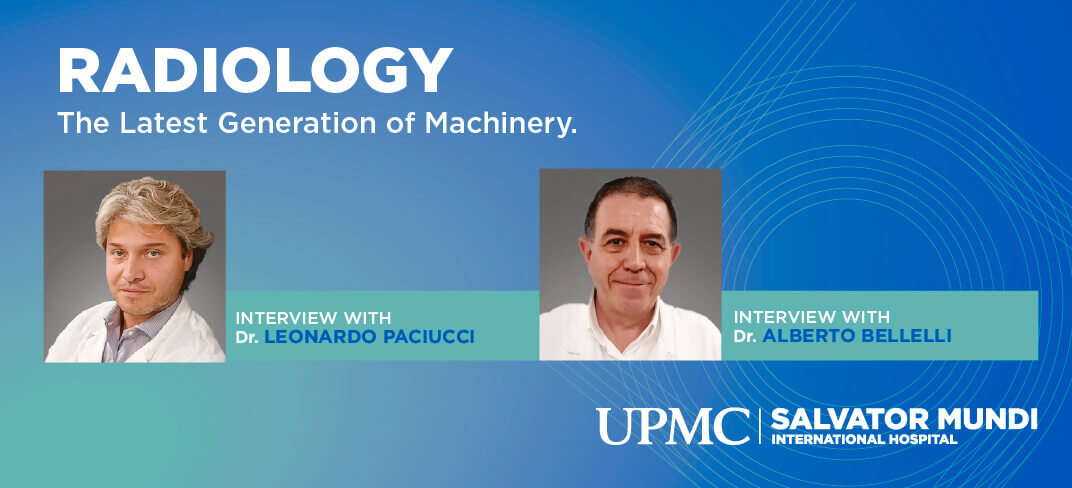Radiology: Discover the Latest Generation of Machinery

Radiology and diagnostic imaging play a crucial role in the prevention and treatment of major diseases. In this interview, we have the privilege of speaking with Dr. Leonardo Paciucci and Dr. Alberto Bellelli, the coordinators of the Radiology and Diagnostic Imaging Center at UPMC Salvator Mundi International Hospital. They will shed light on the groundbreaking advancements in radiology made possible by the latest generation of machines.
At UPMC Salvator Mundi International Hospital, we offer a comprehensive range of highly specialized diagnostic services in radiology, ultrasound, mammography with tomosynthesis, MRI, CT, and MOC examinations.
That's right, all major diagnostic tests are available at SMIH, with a focus on internist, musculoskeletal, and neurological disorders. In-depth studies of the breast, heart, vascular system, urological system, or pediatric conditions-our team of experts is ready to offer accurate and timely diagnosis.
In addition, our center also offers state-of-the-art service in interventional radiology. We collaborate with internationally renowned professionals for micro-invasive treatment of vascular, oncological and musculoskeletal diseases. If you need surgery for aneurysms, strokes, malformations, or if you need biopsies or percutaneous ablations of liver, thyroid, or lung nodules, we are here for you. In addition, we offer treatments for painful states of the spinal cord, the infamous "back pain."
What makes UPMC Salvator Mundi's Radiology and Diagnostic Imaging Center truly exceptional?
The state-of-the-art machines we use. One of our jewels of technology is the Siemens SOMATOM Force computed tomography (CT) scanner. This instrumentation represents a true revolution in the field of diagnostic imaging. Thanks to dual source technology, we obtain scans with spatial resolution on the order of tenths of a millimeter, ensuring images of the highest quality. In addition, by using innovative reconstruction algorithms, we can employ extremely low doses of radiation for all types of examinations. For example, for a CT scan of the chest, we use doses of less than 1 mSv, which are practically harmless to the body. This allows us to reduce even the use of contrast medium by up to 80 percent, which is particularly useful for patients with impaired renal function, frail patients, the elderly and children.
In addition to CT scanning, we have a state-of-the-art mammography machine with tomosynthesis technology, which allows three-dimensional analysis of the mammary gland, greatly increasing diagnostic sensitivity. We also have a high-field MRI, which is constantly updated with the latest software, two high-end ultrasound machines, two fully digitized radiology rooms, and bone densitometry equipment for the study of osteoporosis.
What advantages does the innovative machinery offer in terms of added value, considering the importance of the team of highly qualified specialists?
First, it allows for a significant reduction in diagnostic time, which is crucial for achieving early diagnosis. We all know how early diagnosis can make a difference for the patient, especially in the field of oncology, but also in many other pathological conditions such as trauma, medical emergencies, and sports medicine.
Another important benefit is the expanded access to diagnostic tests for more patients. Thanks to state-of-the-art equipment, we can perform examinations that were previously difficult to access or even contraindicated. For example, our CT scan allows for high-quality cardiology examinations, particularly for the study of the coronary arteries. This instrument can study patients with major heart rhythm alterations, which would be problematic with traditional technologies.
Are more frail, comorbid, or pediatric patients, then, more assisted by high technology? How much of a difference can this make?
Absolutely: thanks to advanced diagnostic machines, we can perform important examinations that in the past were difficult to access or even contraindicated for these patients.
One of the main benefits of high technology is the reduction in radiation dose and contrast medium used during examinations. This means that more frail patients, who may be more sensitive to the effects of radiation or contrast medium, can be studied safely. The reduction in radiation and contrast doses does not compromise the quality of the images obtained, thanks to the advanced processing capabilities of the latest generation of equipment.
In addition, high technology allows for greater precision and resolution in diagnostic images, which is especially useful when dealing with pediatric patients or those with comorbidities. This means that we can obtain more detailed and accurate images, enabling more precise diagnosis and targeted treatment.
In conclusion, high technology makes a significant difference for patients who are frailer, have comorbidities, or are pediatric, enabling them to undergo important diagnostic tests safely and get more accurate diagnostic results. This helps improve the care and management of their medical conditions by providing high-quality, personalized care.
To learn about the Radiology and Diagnostic Imaging Center at UPMC Salvator Mundi click here. To learn about the Radiology and Diagnostic Imaging Center at UPMC Salvator Mundi click here.